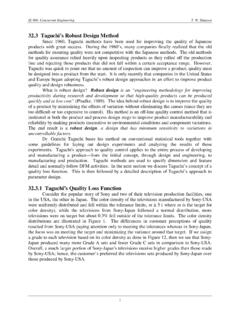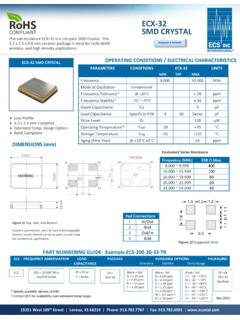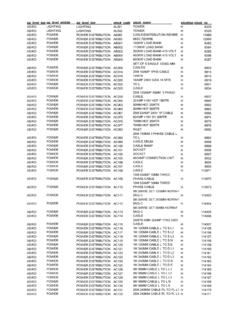Transcription of Mnemonics in a mnutshell: 32 aids to psychiatric diagnosis
1 Current PsychiatryVol. 7, No. 1027 Mnemonics in a mnutshell: 32 aids to psychiatric diagnosis Clever, irreverent, or amusing, a mnemonic you rememberis a lifelong learning tool Jason P. Caplan, MDAssistant clinical professor of psychiatryCreighton University School of MedicineOmaha, NEChief of psychiatrySt. Joseph s Hospital and Medical CenterPhoenix, AZTheodore A. Stern, MDProfessor of psychiatryHarvard Medical SchoolChief, psychiatric consultation serviceMassachusetts General HospitalBoston, MAFrom SIG: E CAPS to CAGE and WWHHHHIMPS, Mnemonics help practitioners and trainees recall important lists (such as criteria for depression, screening questions for alcoholism, or life-threatening causes of delirium, respectively).
2 Mnemonics effi cacy rests on the principle that grouped information is easi-er to remember than individual points of data. Not everyone loves Mnemonics , but recollecting diagnostic criteria is useful in clinical practice and research, on board examinations, and for insurance reimbursement. Thus, tools that assist in recalling di-agnostic criteria have a role in psychiatric practice and teaching. In this article, we present 32 mnemonics to help cli-nicians diagnose: affective disorders (Box 1, page 28)1,2 anxiety disorders (Box 2, page 29)3-6 medication adverse effects (Box 3, page 29)7,8 personality disorders (Box 4, page 30)9-11 addiction disorders (Box 5, page 32)12,13 causes of delirium (Box 6, page 32).
3 14 We also discuss how Mnemonics improve one s memory, based on the principles of learning Mnemonics workA mnemonic from the Greek word mnemonikos ( of memory ) links new data with previously learned information. Mnemonics assist in learning by reducing the amount of information ( cognitive load ) that needs JUPITER IMAGES27_CPSY1008 2727_CPSY1008 279/12/08 3:20:58 PM9/12/08 3:20:58 PMCopyright Dowden Health Media For personal use onlyFor mass reproduction, content licensing and permissions contact Dowden Health PsychiatryOctober 200828 MnemonicsBOX 1. Mnemonics FOR DIAGNOSING AFFECTIVE DISORDERSD epressionSIG.
4 E CAPS*Suicidal thoughtsInterests decreasedGuiltEnergy decreasedConcentration decreasedAppetite disturbance (increased or decreased)Psychomotor changes (agitation or retardation)Sleep disturbance (increased or decreased)* Created by Carey Gross, MDDysthymiaHE S 2 SAD2 HopelessnessEnergy loss or fatigueSelf-esteem is low2 years minimum of depressed mood most of the day, for more days than notSleep is increased or decreasedAppetite is increased or decreasedDecision-making or concentration is impairedManiaDIG FASTD istractibilityIndiscretionGrandiosityFli ght of ideasActivity increaseSleep defi citTalkativenessDepressionC GASP DIE1 Concentration decreasedGuiltAppetiteSleep disturbancePsychomotor agitation or retardationDeath or suicide (thoughts or acts of)
5 Interests decreasedEnergy decreasedHypomaniaTAD HIGH TalkativeAttention defi citDecreased need for sleepHigh self-esteem/grandiosityIdeas that raceGoal-directed activity increasedHigh-risk activityManiaDeTeR the HIGH*DistractibilityTalkativenessReckles s behaviorHyposomniaIdeas that raceGrandiosity Hypersexuality* Created by Carey Gross, MDto be stored for long-term processing and Memory, defi ned as the persistence of learning in a state that can be revealed at a later time, 16 can be divided into 2 types: declarative (a conscious recollection of facts, such as remembering a relative s birthday) procedural (skills-based learning, such as riding a bicycle).
6 Declarative memory has a conscious component and may be mediated by the medial temporal lobe and cortical associa-tion structures. Procedural memory has less of a conscious component; it may involve the basal ganglia, cerebellum, and a variety of cortical sensory-perceptive memory can be subdivided into working memory and long-term memory. With working memory, new items of infor-mation are held briefl y so that encoding and eventual storage can take place. Working memory guides decision-making and future planning and is intri-cately related to Functional MRI and positron emission tomography as well as neurocognitive testing have shown that working memory tasks ac-tivate the prefrontal cortex and brain regions specifi c to language and visuo-spatial memory.
7 The hippocampus is thought to rapidly absorb new information, and this data is consolidated and permanently stored via the prefrontal Given the hippo-campus limited storage capacity, new infor-mation (such as what you ate for breakfast 3 weeks ago) will disappear if it is not re-peated 2828_CPSY1008 289/12/08 3:21:03 PM9/12/08 3:21:03 PMCurrent PsychiatryVol. 7, No. 1029 Clinical PointTKTKC linical PointTKTKBOX 2. Mnemonics FOR DIAGNOSING ANXIETY DISORDERSLong-term memory, on the other hand, is encoded knowledge that is linked to facts learned in the past; it is consolidated in the brain and can be readily studies have demonstrat-ed opposing patterns of activation in the hippocampus and prefrontal cortex, de-pending on whether the memory being recalled is: new (high hippocampal activity, low prefrontal cortex activity) old (low hippocampal activity, high prefrontal cortex activity).
8 27 Mnemonics are thought to affect working memory by reducing the introduced cog-nitive load and increasing the effi ciency of memory acquisition and encoding. They reduce cognitive load by grouping ob-jects into a single verbal or visual cue that can be introduced into working memory. Learning is optimized when the load on BOX 3. Mnemonics FOR DIAGNOSING MEDICATION ADVERSE EFFECTSA ntidepressant discontinuation syndromeFINISH7 Flu-like symptomsInsomniaNauseaImbalanceSensory disturbancesHyperarousal (anxiety/agitation)Neuroleptic malignant syndromeFEVER8 FeverEncephalopathyVital sign instabilityElevated WBC/CPKR igidityWBC: white blood cell countCPK.
9 Creatine phosphokinaseSerotonin syndromeHARMEDH yperthermiaAutonomic instabilityRigidityMyoclonusEncephalopat hyDiaphoresisClinical PointTKTKG eneralized anxiety disorderWorry WARTS3 Wound upWorn-outAbsentmindedRestlessTouchySlee plessPosttraumatic stress disorderTRAUMA5 Traumatic eventRe-experienceAvoidanceUnable to functionMonth or more of symptomsArousal increasedAnxiety disorder due to a general medical conditionPhysical Diseases That HaveCommonly Appeared Anxious: Pheochromocytoma Diabetes mellitus Temporal lobe epilepsy Hyperthyroidism Carcinoid Alcohol withdrawal ArrhythmiasGeneralized anxiety disorderWATCHERS4 WorryAnxietyTension in musclesConcentration diffi cultyHyperarousal (or irritability)Energy lossRestlessnessSleep disturbancePosttraumatic stress disorderDREAMS6 Disinterest in usual activitiesRe-experienceEvent preceding symptomsAvoidanceM onth or more of symptomsSympathetic arousal29_CPSY1008 2929_CPSY1008 299/16/08 12:06:16 PM9/16/08 12:06:16 PMCurrent PsychiatryOctober 200830 MnemonicsBOX 4.
10 Mnemonics FOR DIAGNOSING PERSONALITY DISORDERS working memory is minimized, enabling long-term memory to be Mnemonics may use rhyme, music, or visual cues to enhance memory. Most mne-monics used in medical practice and edu-cation are word-based, including: Acronyms words, each letter of which stands for a particular piece of information to be recalled (such as RICE for treatment of a sprained joint: rest, ice, compression, elevation). Acrostics sentences with the fi rst let-ter of each word prompting the desired recollection (such as To Zanzibar by mo-tor car for the branches of the facial nerve: temporal, zygomatic, buccal, mandibular, cervical).








